Epithelial cells are connected to each other. There are two kinds of extracellular matrices: basilar membrane side and tectorial membrane site. Sound waves trail through the liquid medium, pressing on the tectorial membrane which in turn pushes on the outer hair cells (changes the direction of stereocilia)—> bending cells send out signals to the brain
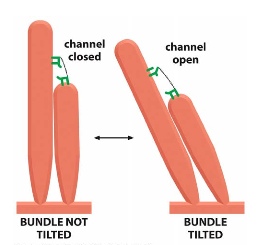
There is tether connected to the ion channels on the stereo cilia that pull open the channels upon its bending —> begins a nerve impulse
Loss of such organization from disease, aging, toxins or noise lead to permanent hearing loss because these cells do not re-grow once damaged or lost.
The stereo cilia are filled and supported by actin, and there is constant turnover of actin—> continually polarized treadmilling.
E.g. photoreceptors

Light reaches neurons projecting to the brain first then photoreceptors last.
Pulse-chase experiment: use radiolabeled leucine to detect proteins and their movement to see if the labeled leucine will be detected in the cells for their entire lifetime (indicates no turnover) OR detected for a short period of time (indicates turnover).
Result, the labeled proteins moves from the cell body of photoreceptors to pigmented epithelial cells. and eventually disappears, which indicate turnover of proteins.
E.g. bone structure
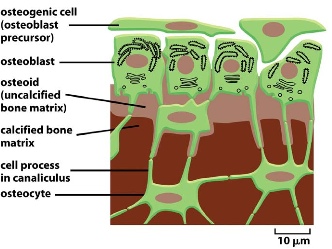
Osteoclasts and osteoblasts act on extracellular matrix and destroys/builds the bone tissue.
The former digests bone to make room for new bone and the latter deposits new bone.
Cellular turnover - tissues have cells that continuously growing and dying. Can be stem cell dependent or independent.
Def. not terminally differentiated, and can divide without limit —resupplying tissues, its daughter cells can either become differentiated cells or remain stem cells.
Usually cell renewal only happens with stem cells, but two exceptions are liver cells and insulin-secreting cells of the pancreas.
<1> Stem cells are regulated so the population of original cells can be maintained, but daughter cells can also become different cells.
a)

**during cell division, one daughter cell receives factors to let it remain a stem cell, while another daughter cell receives factors to let it differentiated. One drawback is that one stem cell only makes one daughter stem cell after division, so if stem cells are lost, their original numbers cannot be restored.
b)
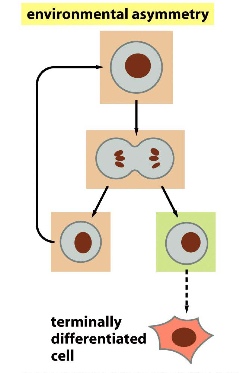
**during cell division, one stem cell makes two stem cells that are identical to itself, then, depending on the environment, the daughter cells can become differentiated cells or remain stem cells. If stem cells are lost, then their numbers can be increased by having boy daughters of the division enter to environment which promotes steaminess —> both can become stem cells so that the stem cell population can be retained. This process can be regulated so both daughter cells can be differentiated/can be retained.
<2> Stem cells divide slowly —> a limited number of stem cells need to supply the body for the entire lifetime. This is to avoid: gaining mutations that are associated with cell division and depleting telomere after each division.
So what can be done to make sure there are enough differentiated cells for tissues coming from stem cells?
A: Committed transit amplifying cells.
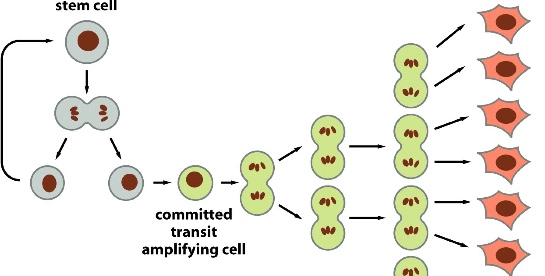
Once a daughter stem cell is fated to become differentiated, it becomes a committed transit amplifying cell. This cell is not a true stem cell for it has only limited capacity of division. Even if it gains mutation along the way, it won’t go back and affect the stem cell population since they are already different. This allows many divisions to occur before all becoming differentiated cells.
<3> Stem cell niche: providing stem cells with factors that promote their steaminess. e.g. Skin stem cells stay in the basal layer which attaches to the basal lamina to remain as stem cells.

basal cell layer (epithelium)
basal lamina (a layer of extracellular matrix material)
If the direction of division is left and right (shown in the picture) then the daughter cells remain in contact with the basal lamina as stem cells, but if the direction is up and down, then one daughter cell will shift upward and become differentiated into a skin cell.
Blood stem cells
- can divide into various population of cells
- originate from the bone marrow: this is shown by an experiment in which all the blood cells in mice are killed with X-irradiation, so that no blood cell production can continue. Then, inject new bone marrow cells from healthy donor—> observed: the injected cells colonizes the tissue and make new blood cells.
- identifying blood stem cells and their progeny: homogenize marrow cells and separate them into individual cells —>expose cells to antibodies which can bind to specific molecules only found on the surface of certain blood cells (basically the binding and later detection of each antibody links to a know blood cell type) —> secondary fluorescent antibody is added [Fluoresence Activating Cell Sorting (FACS)] —> passes through laser so that cells with antibodies are labeled with - charge —> run through electric field so that cells will be separated according to their charge and thus their type.
^^^^after this separation, each type of cells can be injected into mice to see which type is the stem cell. Result: 1/10000 bone marrow cells are actually stem cells (rare); but 5 stem cells are enough to restore the entire blood cell system (potent).
- blood stem cells are maintained through interactions with stromal cells(= cells of connective tissue) in the bone marrow — stromal ells provides a niche for the blood stem cells (similar to basil lamina for skin stem cells)
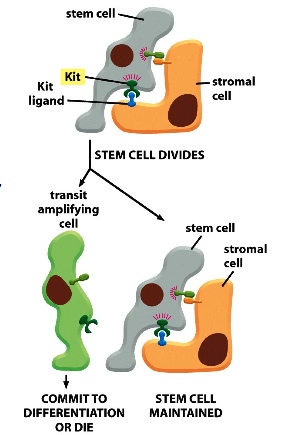 stem cells have Kit (surface receptors) and stromal cells have Kit ligand. Once detached, the stem cell becomes transit amplifying cell.
stem cells have Kit (surface receptors) and stromal cells have Kit ligand. Once detached, the stem cell becomes transit amplifying cell.
Places where stem cells can be regulated:
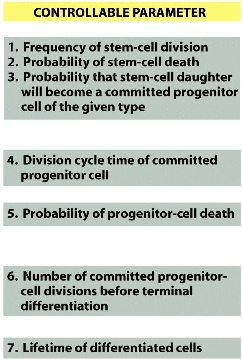
Medical uses for stem cells
1) Leukimia: use irradiation to kill cancer cells found in blood, then use healthy bone marrow from donor to produce new blood cells.
danger: immune rejection (only compatible match can be a donor) But, if it’s not the patient’s stem cells, but downstream cells that become cancerous, the patient’s own stem cells can be used
2)Tissue regeneration: e.g. limb regeneration in newts (including skin, neurone, muscle…cells) — in their amputated limb, the bud has de-differentiated adult cells that are available to become new limb again.
danger: if cell differentiation isn’t properly controlled, cancer can result.